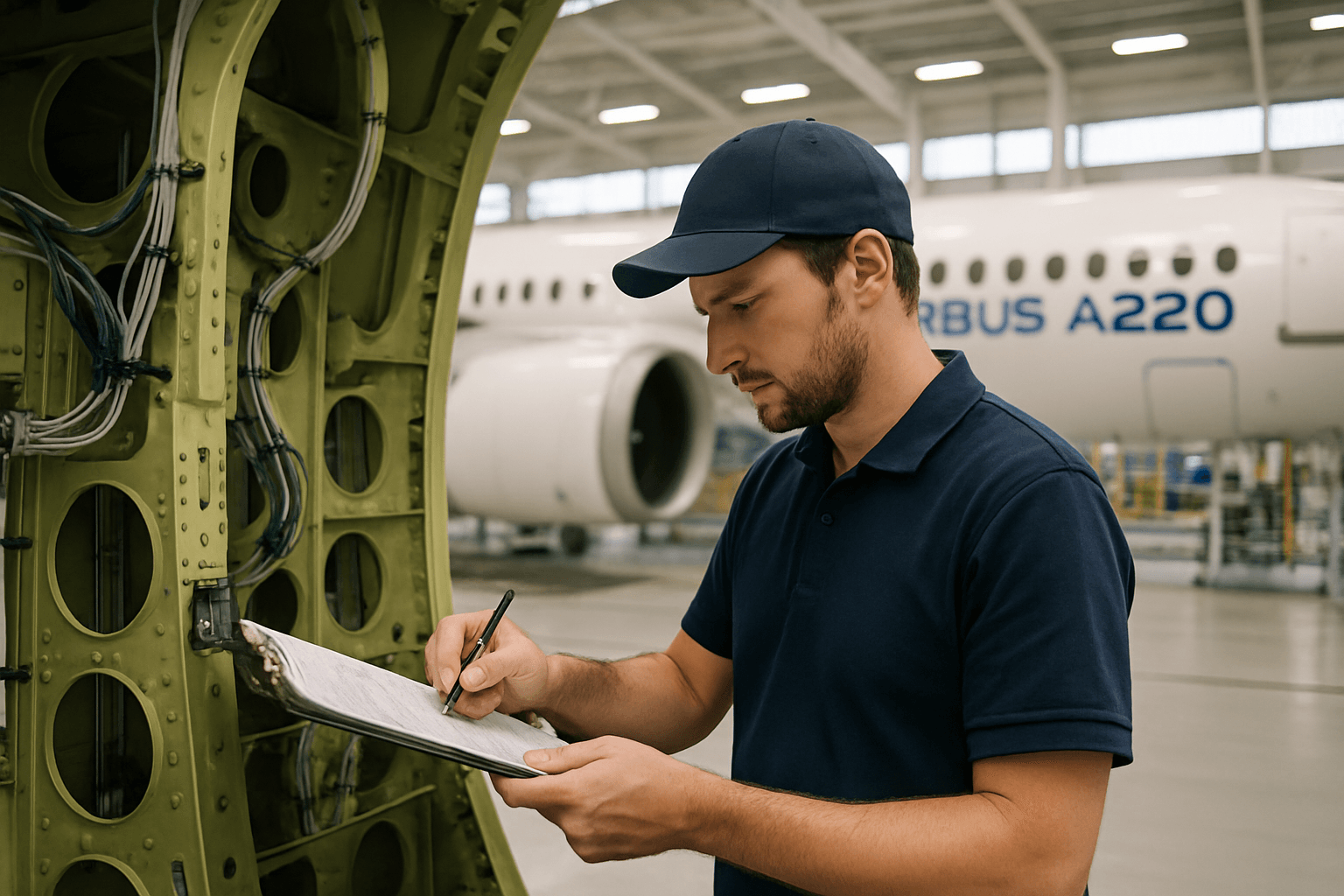Airbus is poised to commence certification work on a 160-seat version of its A220 aircraft this year, a move driven by strong market demand for increased capacity. This development marks a significant step in the evolution of the A220 program, initially developed by Bombardier as the CSeries before Airbus took over in 2018. The certification effort aims to enhance the twinjet’s capabilities and better serve the needs of airlines seeking greater operational efficiency.
Addressing Market Demand
A220 chief engineer Jean-Francois Parent highlighted the “strong request from the market” for a higher seat-count during a briefing in Toulouse on June 11, 2025. This demand stems from airlines looking to maximize passenger capacity on regional and short-to-medium-haul routes, where the A220 excels due to its fuel efficiency and passenger comfort. Carriers like airBaltic have expressed keen interest in a higher-capacity A220 model, indicating a willingness to transition to such a variant if launched.
Certification Requirements and Modifications
The European Union Aviation Safety Agency (EASA) currently permits a maximum of 149 passengers on the A220-300, contingent upon the overwing exits meeting stringent “over-performing” Type III criteria, including a dual-lane evacuation slide. To accommodate 160 passengers, Airbus will need to implement modifications, including the addition of a second overwing exit on each side of the aircraft. This modification ensures the aircraft remains compliant with safety regulations, particularly those concerning emergency evacuation.
Addressing Safety Regulations
Meeting safety regulations is paramount. The introduction of a second overwing emergency exit is not merely about adding more seats; it’s about ensuring the aircraft can safely evacuate all passengers in the event of an emergency. Airbus engineers must demonstrate that the modified configuration adheres to all safety standards, providing effective evacuation capabilities for the increased passenger load. This involves comprehensive certification testing and regulatory approval processes.
Planned Enhancements and Improvements
Beyond the increased seating capacity, Airbus is implementing several other enhancements to the A220 program, drawing lessons from its A320neo program:
- Enhanced Climb Derate: This improvement allows reduced engine use during climb, increasing time-on-wing while retaining maximum climb capability, providing operators with greater flexibility.
- Dual Motoring to Start: A fully automated system enabling crews to start both engines more quickly at the gate, requiring software updates to the full-authority digital engine control and avionics.
- Runway Overrun Awareness and Alerting System (ROAAS): Set to be introduced in 2026, this system will provide flight crews with advanced warning capabilities regarding potential runway excursion risks during landing and takeoff operations, enhancing flight safety.
- New Cabin Interior: Also planned for 2026, featuring larger overhead bins, with Air Canada as the launch customer.
These improvements aim to enhance the A220’s operational efficiency, reduce maintenance downtime, and improve the overall passenger experience.
Engine Improvements
Changes since the A220’s service entry have resulted in a “significant improvement” in time-on-wing for the Pratt & Whitney PW1500G engines. The current configuration addresses 90% of engine-removal drivers. Airbus is also exploring enabling airlines to climb at derated power levels to reduce strain on the aircraft, similar to a feature in development for the A320.
Market Positioning and Competition
The A220 family competes with aircraft like the Boeing 737 MAX 7 and the Embraer E195-E2. Airbus estimates it controls up to 60% of the 100-150 seat market segment. Airbus foresees delivering approximately 7,000 units in the A220’s market segment over the next 20 years.
Filling a Market Gap
The A220 is well-positioned to fill the gap left by the underperforming A319neo. With its increased seating capacity and enhanced operational capabilities, the A220 could become a preferred choice for airlines looking to replace older, less efficient aircraft.
Production and Deliveries
Airbus aims to manufacture 14 A220s per month by 2026, split between its production plants in Mirabel and Mobile. However, production rates have faced challenges, including labor disputes and supply chain constraints.
Impact of Increased Capacity on Production
Ramping up production to meet the demand for the 160-seat A220 will require careful management of the supply chain and efficient manufacturing processes. Airbus has invested in expanding its production capabilities to support the A220 program. Successfully increasing production rates will be crucial to meeting the needs of airlines seeking to modernize their fleets with the A220.
The A220-500: A Potential Stretched Variant
There has been speculation about a potential stretched variant of the A220, dubbed the A220-500, which could seat over 180 passengers. While Airbus has downplayed rumors of an imminent launch, the possibility of such a variant remains a topic of discussion.
Challenges and Considerations
Launching the A220-500 presents several challenges, including the risk of cannibalizing sales of the A320neo and the need for significant investments in development and production. However, the A220-500 could offer a compelling option for airlines seeking a larger, more efficient narrow-body aircraft.
Operators and Orders
The A220 has garnered significant interest from airlines worldwide, with notable operators including:
- Delta Air Lines
- airBaltic
- JetBlue
- Air Canada
Future Orders
Airbus anticipates further orders for the A220, driven by the aircraft’s fuel efficiency, passenger comfort, and operational capabilities. The 160-seat version is expected to attract additional interest from airlines looking to optimize their fleets for regional and short-to-medium-haul routes.
Passenger Experience
The A220 is designed with passenger comfort in mind, offering features such as:
- Wide seats
- Large windows
- Spacious overhead bins
- In-flight entertainment systems
- Wi-Fi connectivity
These features contribute to a more enjoyable flying experience, making the A220 a popular choice among passengers.
Cabin Innovations
Airbus is continuously working to improve the A220’s cabin, with plans to introduce new cabin interiors featuring larger overhead storage compartments in 2026. These enhancements will further enhance the passenger experience and address concerns about baggage storage capacity.
Sustainable Aviation
The A220 is engineered for fuel efficiency, with research suggesting a 25% lower fuel burn per seat compared to previous-generation aircraft. This is achieved through advanced aerodynamics, lightweight materials, and Pratt & Whitney PW1500G engines. The A220 is also compatible with sustainable aviation fuel (SAF), further reducing its carbon footprint.
Environmental Benefits
The A220’s fuel efficiency and reduced emissions make it a more environmentally friendly option for airlines. As the aviation industry increasingly focuses on sustainability, the A220 is well-positioned to meet the growing demand for greener aircraft.
Training and Support
airBaltic Training offers a Type Rating Course for the Airbus A220-300, providing pilots with the necessary training to operate the aircraft safely and efficiently. Airbus also provides comprehensive support services to A220 operators, ensuring the aircraft’s continued reliability and performance.
Investment in Training
As the A220 fleet continues to grow, investments in training and support will be crucial to ensuring the aircraft’s safe and efficient operation. Airbus and its partners are committed to providing airlines with the resources they need to succeed with the A220.
Conclusion
The commencement of certification work on the 160-seat A220 marks an exciting chapter in the aircraft’s development. Driven by strong market demand and incorporating numerous enhancements, this higher-capacity version promises to further solidify the A220’s position as a leader in the single-aisle market. With its fuel efficiency, passenger comfort, and operational capabilities, the A220 is well-equipped to meet the evolving needs of airlines and passengers alike. As Airbus continues to innovate and invest in the A220 program, the future looks bright for this game-changing aircraft.





